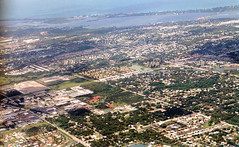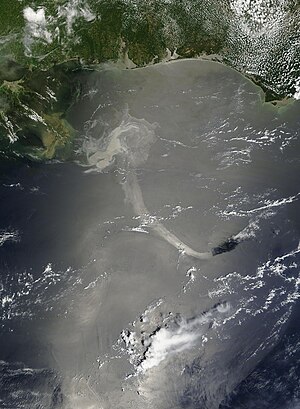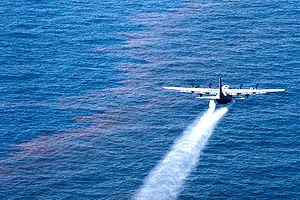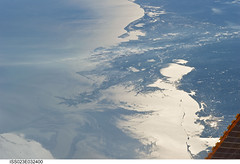 Sign
protesting use of toxic "Corexit" chemical dispersant in the BP Gulf of
Mexico oil disaster, at the Bastille Day Tumble, French Quarter, New
Orleans. (Photo credit: Wikipedia)
Sign
protesting use of toxic "Corexit" chemical dispersant in the BP Gulf of
Mexico oil disaster, at the Bastille Day Tumble, French Quarter, New
Orleans. (Photo credit: Wikipedia) New
Orleans. "BP Oil Flood Protest, Jackson Square. Protest agains the
great oil spill disaster in the Gulf of Mexico. (Photo credit: Wikipedia)
New
Orleans. "BP Oil Flood Protest, Jackson Square. Protest agains the
great oil spill disaster in the Gulf of Mexico. (Photo credit: Wikipedia) New
Orleans. "BP Oil Flood" Protest, Jackson Square. Protest against the
great oil spill disaster in the Gulf of Mexico. (Photo credit:Wikipedia)
New
Orleans. "BP Oil Flood" Protest, Jackson Square. Protest against the
great oil spill disaster in the Gulf of Mexico. (Photo credit:Wikipedia) Sarasota - Gulf Gate East and Vicinity from the Air (Photo credit: roger4336)
Sarasota - Gulf Gate East and Vicinity from the Air (Photo credit: roger4336) English:
Deepwater Horizon oil spill imagined in true color on May 17 by MODIS
instrument aboard NASA's TERRA satellite. (Photo credit: Wikipedia)
English:
Deepwater Horizon oil spill imagined in true color on May 17 by MODIS
instrument aboard NASA's TERRA satellite. (Photo credit: Wikipedia) English:
A C-130 Hercules from the Air Force Reserve Command's 910th Airlift
Wing at Youngstown-Warren Air Reserve Station, Ohio, drops an
oil-dispersing chemical into the Gulf of Mexico May 5, 2010, as part of
the Deepwater Horizon Response effort. The 910th AW specializes in
aerial spray and is the Department of Defense's only large-area,
fixed-wing aerial spray unit. (Photo credit: Wikipedia)
English:
A C-130 Hercules from the Air Force Reserve Command's 910th Airlift
Wing at Youngstown-Warren Air Reserve Station, Ohio, drops an
oil-dispersing chemical into the Gulf of Mexico May 5, 2010, as part of
the Deepwater Horizon Response effort. The 910th AW specializes in
aerial spray and is the Department of Defense's only large-area,
fixed-wing aerial spray unit. (Photo credit: Wikipedia) Oil Spill, Gulf of Mexico (NASA, International Space Station Science, 05/04/10) (Photo credit: NASA's Marshall Space Flight Center)
Oil Spill, Gulf of Mexico (NASA, International Space Station Science, 05/04/10) (Photo credit: NASA's Marshall Space Flight Center)Dispersants can turn oil spills into toxic mist Mar 21 2018
Dispersamts from BP spill make people sick Sept 2017
Corexit Search ( Later post after Search worked again )
7 February - Corexit
July 4 2010 Hundreds of people get sick after swimming in the Gulf
September 6 2010 Corexit found in swimming pool 1 hour north of Tampa, family deathly sick
24 April 2011 EPA's Coverup of Gulf Oil Spill Sickness
Remember this ?
along comes Keven Costner with a machine that actually extracts the oil out of water by a centrifugal method, without using chemicals.
Costner had tried for weeks, precious time wasted to get his machine approved through the US Congress who took their sweet time looking it over. Did it work? Yes it did.
If Costner would have had those machines on board the ships that were carrying oil out for BP profits, they could have saved the Gulf from the billions of gallons of oil spilled into the water.
Blood Tests Show Chemicals in Gulf Citizens Blood- US Government Lied about Gulf Seafood
January 5, 2011
The scandalous silence of the EPA, Obama, the MSM and Congress
People are getting sick in the Gulf states and the sick are getting worse. Meanwhile, the MSM, EPA, President Obama and the rest of the merry band of government goofs that inhabit DC ignore the continued spraying of Corexit. Maybe if BP sprayed DC for a few weeks, it would get someone’s attention?
27 March 2013
It was a simple 3 word Search : "corexit oil sickness"
Google 1 page of results. More listed. Will not advance past page 1
Yahoo 1 page of results. More listed. Will not advance past page 1
Bing 1 page of results. More listed. Will not advance past page 1
That's new. I cannot recall similar results in the past - though each service was stuck on different results. I recall stories of investigators being killed when I was reading
Florida Oil Spill Law
Documenting the BP/Deepwater Horizon Oil, Gas, & Dispersant Disaster
but stopped checking when it stopped collecting intel . Their results
today look like those of Search....though Search of the past when
relevant results were available at iGoogle.
They don't seem to have changed, though. Not in evidence are stories
relating to weather changes ( storms ) over the Gulf, downstream results
from the polluted water entering the ocean and flowing up the East
coast with mysterious deaths of sea life and even a redirection of warm
water flow to the Arctic. ( Pour oil on water. It becomes calm and
evaporation is affected )
- EPA Accused of Violating the Clean Water Act
- The BP Gulf Oil Spill Info Blackout And Data Lockdown
- LESSONS NOT LEARNED — INEFFECTIVE OIL SPILL RESPONSE
- Conclusive Evidence That BP Misrepresented Gulf Oil Spill Sent To Congress
- The Gulf of Mexico is Dying
These entries are for oilgate.wordpress. The RSS is being added to My Yahoo! but there has not been much activity.
“FIRST DISPERSANT STUDY FUNDED BY FEDS: COREXIT “DID NOT DEGRADE”… “IT DIDN’T GO AWAY” — MAY NOT HAVE EVEN BROKEN UP THE OIL” – FLORIDA OIL SPILL LAW
News Release : First Study of Dispersants in Gulf Spill Suggests a Prolonged Deepwater FateSource: Woods Hole Oceanographic Institution, January 26, 2011
The Dirty Truth About Bp Gulf Oil Spill Dispersant: Nalco Corexit
DogPile Aha. More services are available, of course, but let's see what is interesting.
Democratic Underground Archives » General Discussion (1/22-2007 thru 12/14/2010)
BP dispersants 'causing sickness' (gruesome symptoms)
At roughly the same time Matsler was exposed, local television station WKRG News 5 took a water sample from his area to test for dispersants. The sample literally exploded when it was mixed with an organic solvent separating the oil from the water.
Hugh Kaufman, an EPA whistleblower and analyst, has reported this of the effects of the toxic dispersants:
"We
have dolphins that are hemorrhaging. People who work near it are
hemorrhaging internally. And that’s what dispersants are supposed to
do..."
By the middle of last summer, the Alabama Department of
Public Health said that 56 people in Mobile and Baldwin counties had
sought treatment for what they believed were oil disaster-related
illnesses.
HuffPost - Corexit
Oct 6 2010 HuffPost - The Blog
Corexit Use Still Appears to Be Prevalent in the Gulf, Despite Official Statements
Since the blown-out well at the Mississippi Canyon 252 Macondo site has been capped and the cleanup operations in the Gulf declared a success, BP has summarily fired thousands of workers without notice who were left unemployed as a result of the disaster. Local, state and federal agencies have been working to present a picture of normalcy, declaring the seafood safe to eat, the beaches clean and the water free from oil. The actual situation along the Gulf Coast is far from normal, with many people evacuating due to sickness and financial distress. Independent scientific reports continue to conclude the safety of the seafood is questionable at best, the beaches remain thoroughly contaminated, and the majority of the oil and dispersant is still in the water column or at the bottom of the Gulf.
Private Seafood Tests Uncover Toxins Missed By Feds
Susan Buchanan | Posted 05.25.2011 | Business
Read More: New Orleans, Epa, US Coast Guard, Bp, Corexit, Louisiana Environmental Action Network, Cadmium, Fda, Shrimp, Oil, Oysters, Dispersants, NOLA Emergency Response, Noaa,Louisiana Bucket Brigade, {$entry.entry_vertical} News
Not Available
Article: BP Oil plus Corexit Dispersant Equal Bioaccumulation -
Environmental effects of BP's oil spill and spraying Corexit may not be
known for 20 years or more.
Being exposed to the dispersants used in the BP oil spill has left him unable to walk, caused him to have seizures and go blind.
AbundantHope.net True US History Mar 13 2013
Dave Hodges
Activist Post
Voices From the Gulf: “We Are Being Poisoned” (Pt. 3)
The EPA told BP to
not use Corexit because it knew the deadly consequences. BP gave the
EPA the big middle finger and showed the federal government who was
really in charge.
Kim Anderson’s Oregon State University (OSU)
team of researchers, from the OSU College of Agricultural Sciences,
began a test-retest comparative analysis for the carcinogenic
contaminant polycyclic aromatic hydrocarbons (PAHs), and its
biodegradable partner, OPAHs, which appears after the application of
Corexit and subsequent exposure to ultraviolet rays. Stunningly, the OSU researchers found a 40 fold increase in these carcinogenic compounds in
the comparative test-retest period.The omnipresent dangers to Gulf
Coast residents is self-evident in light of this research. It is noteworthy that the OSU researchers had the first draft of their report stolen before the results could be published.
Award
winning chemist, Dr. Wilma Subra, conducted blood tests on Gulf Coast
residents who were symptomatic with new illnesses and found that some of
the cancer-causing agents were 65 times the expected level in the
victims blood tests. Subra noted that Corexit is in the air, the water
and the Gulf resident’s blood.
“There’s
a whole population that’s very sick and doesn’t have access to medical
care, and that’s what we’ve been trying to work on now, from the very
beginning, is getting them medical care so they will get better,” says
Subra. “How many people do you think we’re talking about, do we have any
guess?” “Hundreds of thousands along the whole coastal area,” Subra
says. “Hundreds of thousands of people?” “That are sick, yes.”
You have a recipe for something much worse than acid rain.
Speaking of acid raid, this is exactly what has been discovered in North Carolina and in the Memphis area where crops were being destroyed from acid rain laced with Corexit.
Why
doesn’t anyone ask why BP insisted on Corexit as the dispersant of
choice? Well, Amy Goodman of Democracy Now! did ask the question of
former EPA official, Hugh Kaufman.
The most damning account of the Corexit dangers posed to the Gulf comes from Hugh Kaufman, senior policy analyst at the EPA’s Office of Solid Waste and Emergency Response as he stated on Democracy Now! that
“In light of the EPA’s data, BP’s decision
to use Corexit 9500 and 9527 was based solely upon an attempt to profit
on the clean-up and not carry out BP’s expressed desire to clean up the
Gulf Coast environment”…these dispersants were used in massive quantities, to hide the magnitude of the spill and save BP money…Both
EPA, NOAA, etc, have been sock puppets for BP in this cover-up. Now, by
hiding the amount of spill, BP is saving hundreds of millions, if not
billions, of dollars in fines…People who work near it (the dispersants)
are hemorrhaging internally. EPA now is
taking the position that they really don’t know how dangerous it is,
even though if you read the label, it tells you how dangerous it is. And, for example, in
the Exxon Valdez case, people who worked with dispersants, most of them
are dead…The average death age is around fifty. It’s very dangerous…
The Gulf is still leaking oil and
Corexit is still being covertly sprayed, most at night and by unmanned
planes and there is growing evidence that the damage may be permanent
due to a hole created in the ocean floor by the initial explosion.
Disturbingly,
the Corexit laced toxic rain may be a fixture in the transpiration
cycle. This means that Corexit could be falling from skies in a variety
of locations far away from the Gulf.
When
one pours more than two million gallons of toxic chemical dispersants
on top of an oil spill, it doesn’t just disappear. In this case, it
moves to the atmosphere, where it will travel hundreds, if not thousands
of miles from the site of the BP oil spill, in the form of toxic rain.
And when the rain falls to earth on grass consumed by cows, the damage
to the food chain moves beyond the fish in the ocean as dairy and beef
are now contaminated. As with Fukushima, we are all affected.
The European Union Times reports in a “disturbing report prepared for President Medvedev by Russia’s Ministry of Natural Resources is warning today that the BP oil and gas leak
in the Gulf of Mexico is about to become the worst environmental
catastrophe in all of human history threatening the entire eastern half
of the North American continent with 'total destruction'”.
© Copyright by AbundantHope.net all rights reserved
Speaking of acid raid, this is exactly what has been discovered in North Carolina and in the Memphis area where crops were being destroyed from acid rain laced with Corexit.
Why doesn’t anyone ask why BP insisted on Corexit as the dispersant of choice? Well, Amy Goodman of Democracy Now! did ask the question of former EPA official, Hugh Kaufman.
The most damning account of the Corexit dangers posed to the Gulf comes from Hugh Kaufman, senior policy analyst at the EPA’s Office of Solid Waste and Emergency Response as he stated on Democracy Now! that
“In light of the EPA’s data, BP’s decision to use Corexit 9500 and 9527 was based solely upon an attempt to profit on the clean-up and not carry out BP’s expressed desire to clean up the Gulf Coast environment”…these dispersants were used in massive quantities, to hide the magnitude of the spill and save BP money…Both EPA, NOAA, etc, have been sock puppets for BP in this cover-up. Now, by hiding the amount of spill, BP is saving hundreds of millions, if not billions, of dollars in fines…People who work near it (the dispersants) are hemorrhaging internally. EPA now is taking the position that they really don’t know how dangerous it is, even though if you read the label, it tells you how dangerous it is. And, for example, in the Exxon Valdez case, people who worked with dispersants, most of them are dead…The average death age is around fifty. It’s very dangerous…
The Gulf is still leaking oil and
Corexit is still being covertly sprayed, most at night and by unmanned
planes and there is growing evidence that the damage may be permanent
due to a hole created in the ocean floor by the initial explosion.
Disturbingly, the Corexit laced toxic rain may be a fixture in the transpiration cycle. This means that Corexit could be falling from skies in a variety of locations far away from the Gulf.
When one pours more than two million gallons of toxic chemical dispersants on top of an oil spill, it doesn’t just disappear. In this case, it moves to the atmosphere, where it will travel hundreds, if not thousands of miles from the site of the BP oil spill, in the form of toxic rain. And when the rain falls to earth on grass consumed by cows, the damage to the food chain moves beyond the fish in the ocean as dairy and beef are now contaminated. As with Fukushima, we are all affected.
Disturbingly, the Corexit laced toxic rain may be a fixture in the transpiration cycle. This means that Corexit could be falling from skies in a variety of locations far away from the Gulf.
When one pours more than two million gallons of toxic chemical dispersants on top of an oil spill, it doesn’t just disappear. In this case, it moves to the atmosphere, where it will travel hundreds, if not thousands of miles from the site of the BP oil spill, in the form of toxic rain. And when the rain falls to earth on grass consumed by cows, the damage to the food chain moves beyond the fish in the ocean as dairy and beef are now contaminated. As with Fukushima, we are all affected.
The European Union Times reports in a “disturbing report prepared for President Medvedev by Russia’s Ministry of Natural Resources is warning today that the BP oil and gas leak in the Gulf of Mexico is about to become the worst environmental catastrophe in all of human history threatening the entire eastern half of the North American continent with 'total destruction'”.
Part Four.
Fair Use claimed. This is excerpted from their article - which itself is from other sources.
CHEMICAL DISPERSANTS BEING USED IN GULF CLEAN-UP ARE POTENTIALLY TOXIC
Tom PhilpottGrist 6 May 2010
these dispersants both contain versions of a disturbing statement. 9500's states that "Component substances have a potential to bioconcentrate," while the one for 9527A has the slightly more comforting, "Component substances have a low potential to bioconcentrate."
This is not what you want to hear about toxins being dumped in the sea by the hundreds of thousands of gallons. The EPA defines bioconcentration as the "accumulation of a chemical in tissues of a fish or other organism to levels greater than in the surrounding medium." In other words, substances that bioconcentrate tend to move from water into fish, where they can do damage to the fish itself, as well as be passed on to predator fish - and on up the food chain, to human eaters.
Comment: For more information about how toxic chemicals bioconcentrate in animals and humans after years of exposure read the following article: Food in the U.S. is Still Tainted with Chemicals That Were Banned Decades Ago.
Both data sheets include the warning "human health hazards: acute." The MSDS for Corexit 9527A states that "excessive exposure may cause central nervous system effects, nausea, vomiting, anesthetic or narcotic effects," and "repeated or excessive exposure to butoxyethanol [an active ingredient] may cause injury to red blood cells (hemolysis), kidney or the liver."
It adds: "Prolonged and/or repeated exposure through inhalation or extensive skin contact with EGBE [butoxyethanol] may result in damage to the blood and kidneys."
Petroleum distillates and 2-Butoxyethanol are both solvents; neither are substances you'd excitedly dump into a vibrant ecosytem. According to its International Chemical Scorecard, 2-Butoxyethanol "may be absorbed" by the skin; causes "cough, dizziness, drowsiness, headache, nausea, and weakness" when inhaled; and "abdominal pain, diarrhea, nausea, and vomiting" when ingested. For petroleum distillates, the International Chemical Scorecard has similar indications about exposure for humans, and adds this unsettling line: "The substance is harmful to aquatic organisms."
we are likely further damaging to a fragile ecosystem in the name of saving it, and imperiling the health of seafood eaters for years to come.
Nov 8 2010
Gulf Sickness – Corexit Still Being Sprayed – People Will DieIn Mississippi, at the Biloxi Regional Medical Center, victims of the Corexit Spraying and other chemicals in the Gulf are being tested by doctors. Is it the flu? Is it acid reflux? Workers, from the Gulf, are coughing up blood, getting dizzy and passing out. Officials are slow to deliver any conclusions.

























